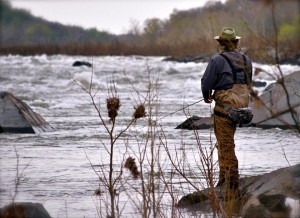 April showers bring cherry blossoms and tourists to the Mid-Atlantic. Since cherry trees were first planted around the Tidal Basin in 1912, people from all over the world travel to Washington D.C. to welcome the arrival of spring. This is also the time when fishermen look forward to other visitors making their way up the Potomac. In late March, the hickory shad run begins bringing some of the most exciting fishing of the year.
April showers bring cherry blossoms and tourists to the Mid-Atlantic. Since cherry trees were first planted around the Tidal Basin in 1912, people from all over the world travel to Washington D.C. to welcome the arrival of spring. This is also the time when fishermen look forward to other visitors making their way up the Potomac. In late March, the hickory shad run begins bringing some of the most exciting fishing of the year.
Hickory and white shad are anadromous species that spend the vast majority of their lives at sea, but enter the Chesapeake region in the spring. They swim through the Bay and up the rivers looking for the fast water they need in order to spawn. Shad hold an important place in American history. The Native Americans fished for them extensively and used them to fertilize their crops. George Washington was known as a prolific shad angler and caught thousands near his home on at Mount Vernon. It was the spring shad run in Pennsylvania’s Schuylkill River that saved Washington’s army from starvation at Valley Forge. You can read about it in the Shad Foundation’s Shad Journal.
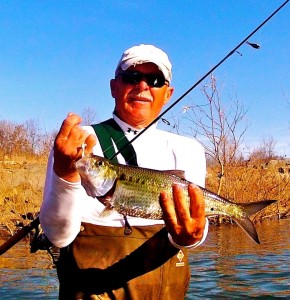 Shad are amazingly flashy fighters. Once hooked, these “poor man’s tarpon” make very strong and fast runs. It’s not unusual for them to jump three feet out of the water as they try to throw the lure. If you happen to catch two at the same time on a tandem rig, don’t be surprised if they snap a 10 pound-test line. White shad are threatened but Hickory shad are relatively abundant. Because of the difficulty in telling them apart, Maryland and Washington D.C. requires both species to be immediately released. White shad are distinguishable from hickory shad by the saw-like scales along their body. They’re wider, and lack the protruding lower jaw of their close cousins. It’s unusual to catch very many white shad. Here are some good pictures to help you tell them apart courtesy of Fletcher’s Boathouse. While you’re there, check out Dan Ward’s fishing reports. Not only is Dan a good fisherman, but he’s an excellent writer.
Shad are amazingly flashy fighters. Once hooked, these “poor man’s tarpon” make very strong and fast runs. It’s not unusual for them to jump three feet out of the water as they try to throw the lure. If you happen to catch two at the same time on a tandem rig, don’t be surprised if they snap a 10 pound-test line. White shad are threatened but Hickory shad are relatively abundant. Because of the difficulty in telling them apart, Maryland and Washington D.C. requires both species to be immediately released. White shad are distinguishable from hickory shad by the saw-like scales along their body. They’re wider, and lack the protruding lower jaw of their close cousins. It’s unusual to catch very many white shad. Here are some good pictures to help you tell them apart courtesy of Fletcher’s Boathouse. While you’re there, check out Dan Ward’s fishing reports. Not only is Dan a good fisherman, but he’s an excellent writer.
This year’s shad run is strong. There are lots of fish and they are running fairly large. I’ve made the short drive from my K street office up the Potomac River to the C&O Canal National Historical Park a couple of times. I also fished with Rich Jenkins last weekend and made another Sunday trip yesterday.
Although rowboats are available for rent at Fletcher’s Cove, I usually wear waders and walk the shore. My usual rig for spin casting is two shad darts, maybe one white and the other chartreuse. I 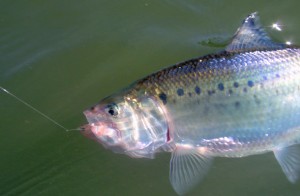 think the smaller the better, but you need a little weight to get the lure out to where the fish are, so I generally go with an eighth-ounce and a sixteenth-ounce fly. Look for shad darts with long-shank hooks and short hair because shad usually chase the lures and strike at the tails. When they are running strong you can see them spawning in the fast water and it’s not unusual to get two or three strikes on every cast.
think the smaller the better, but you need a little weight to get the lure out to where the fish are, so I generally go with an eighth-ounce and a sixteenth-ounce fly. Look for shad darts with long-shank hooks and short hair because shad usually chase the lures and strike at the tails. When they are running strong you can see them spawning in the fast water and it’s not unusual to get two or three strikes on every cast.
Here are some tips for successful shad fishing. Look for pockets of slower, deeper water near areas where there is a lot of current. Still water or eddys behind rocks can be good. I think you need water at least 3-feet, and 6-feet is better, but you can occasionally catch them shallower. Cast upstream at a 45-degree angle as far as you can. Le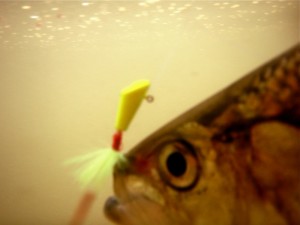 t your lure sink and follow it downstream with the rod tip. Once the lure is opposite you, raise your rod tip and let the current sweep it around while reeling very slowly, just enough to keep it barely above the rocks. It’s okay if you bump the rocks a little, so take plenty of lures because you’re likely to hang up. Twitch the jigs occasionally and experiment with different speeds. (This is very similar technique to a successful one we use for striper fishing with heavy jigs in high current situations.)
t your lure sink and follow it downstream with the rod tip. Once the lure is opposite you, raise your rod tip and let the current sweep it around while reeling very slowly, just enough to keep it barely above the rocks. It’s okay if you bump the rocks a little, so take plenty of lures because you’re likely to hang up. Twitch the jigs occasionally and experiment with different speeds. (This is very similar technique to a successful one we use for striper fishing with heavy jigs in high current situations.)
Flycasting for shad is also a lot of fun. I learned a lot of what I know about it from my fishing buddy Jon Griffiths. I think a six weight is about right but you can go with a seven or eight. Full sinking line is a must. Jon will sometimes tie on two flies to increase his chances. Anything small and flashy will work in sizes 2 to 8. Weighted eyes will get the flies down deeper in the fast water. There is a lot of brush on the banks, so backcasting can be difficult.
Shad don’t really have teeth and they don’t strike hard. It’s more like a little bump. When you feel it, set the hook shortly and sharply, but not too hard. Their mouths are soft and the lure will pull out if 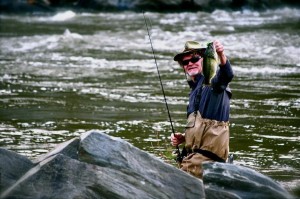 you play them too aggressively. Although I sometimes get away with braid, monofilament on a limber rod is the best equipment. Shad run in schools, so if you catch one, cast back out quickly as there may be more waiting. Also, look for patterns in colors and retrieves. What works one day may not work the next. Early morning and late evening are the best times to fish.
you play them too aggressively. Although I sometimes get away with braid, monofilament on a limber rod is the best equipment. Shad run in schools, so if you catch one, cast back out quickly as there may be more waiting. Also, look for patterns in colors and retrieves. What works one day may not work the next. Early morning and late evening are the best times to fish.
I shot some video of last Sunday’s trip with Rich Jenkins with my cap cam. It probably tells the story better than I can. There’s more information about shad fishing located on Maryland DNR’s website including directions to other productive fishing spots. The shad run will last another two or three weeks with more white shad showing up in late April into early May. If you go, take some bass lures too because both large and smallmouth are hitting well. You might also be surprised by a trophy striper since there are some big ones there now. Hope you can make it out. The shad run is a once-a-year event that no mid-Atlantic fisherman should miss.




In my previous life (pre-LTJ for Bay rock), I lived for flyfishing hickories in Deer Creek and the Gunpowder River. When the forcythias started to bloom, I knew I could a get few and when the Dogwoods began to bloom it was game on.
Very informative as always. Thank you.
SHawn, I remember something similar to this you wrote about four years ago. I live in the District but I had not fished the river for shad up until I read that. Now I followed your advice and boy did I have fun. Just like you, I can’t wait for the shad run to start. I was catching them this year in late March. You might remember than I sent you a note last year about it when I bought your book. Thanks again. The video is great!
I did very well last week up on the Susquehanna.
It is always interesting trying to explain why shad strike.
Imagine: you have survived migrating for several thousand miles thru ice cold water, avoiding predators, seals, large fish, and herons to have sex, which you only have once per year.
Just when it is about to happen, something irritating flashes in front of your face. You don’t have hands and you have a brain the size of a BB. Now, what are you going to do?
Always enjoy your posts. That “cap cam” worked real well. You probably know about the “shad cam” but I’ve just started watching lately. Hadn’t seen many shad and then tonight I tuned in expecting it to be dark like the “osprey cam” but nooooo… it was lit up at night and there were a bunch of eels passing thru. I figure the stripers aren’t far behind! See ya on the water.
http://www.dgif.virginia.gov/fishing/shadcam/
I was in the Pocomoke this weekend and they were running there as well.
If Rich only got 3 and you got 50+….good thing you got a pic when you did…:-)
ive never caught shad but ive caught lady fish, they cal those the poormans tarpon. they look like shad to
Jamie, good thing he can write because he sure can’t count.
Looks like you all tore into them. Be careful with those things. They’ll throw a hook in you!!!